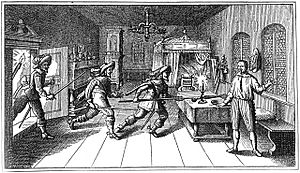Walter Butler of Roscrea facts for kids
Walter Butler of Ballinakill Castle, Roscrea (c. 1600 – 25 December 1634) was a military officer, who served as a colonel (Oberst) in the Imperial Army under Albrecht von Wallenstein and was involved in Wallenstein's assassination in 1634.
Ballinakill Castle
Ballinakill Castle lies between Roscrea and Dunkerrin. The ruins can now be seen on the main Dublin-Limerick road (N7) about six kilometers on the Nenagh side of Roscrea. It is more of a fortified house than a true castle, similar to Cloncourse Castle. The exact date of the fortification is uncertain but is no earlier than 1580 when Pierce Butler of Paulstown bought land there. The three story fortified house has long been gutted and only the shell remains of this large building. What is most impressive about the site however, is not the house but the impressive bawn around it. A bawn is very similar to the curtain walls of a castle. The bawn at Ballinakill is still one of the finest in the country. The castle was acquired by Sir Richard Stephens, who sold it in 1680 to a former Cromwellian soldier, Col. Charles Minchin. His descendants, two of whom were High Sheriffs of Tipperary, added a house at the southern end. Humphrey Minchin moved to England in 1760.
Career

When his family estates in Roscrea, County Tipperary were confiscated in 1616, Walter became a soldier of fortune. He entered the armed forces of the Habsburg emperor Ferdinand II and served with distinction as a colonel in the Thirty Years’ War. In 1631 he and his Irish officers fought under General Tilly against MacKay's Swedish regiment laying siege to Frankfurt-an-der-Oder. Injured and captured by the Swedish, he was accused of being responsible for the loss of the Oder fortress. Butler made King Gustavus Adolphus of Sweden certify his bravery and after his release appeared at the Imperial headquarters before Field Marshal Rudolf von Tiefenbach, where his opponents had to withdraw their accusations.
In 1632 he joined the armed forces under Wallenstein, who, in view of the Swedish progress, had been again appointed Imperial commander-in-chief by Emperor Ferdinand II. Butler quickly gained the trust of the Generalissimo and was appointed Colonel of a dragoon regiment. While the Imperial army fought against the Swedish at Zirndorf and Lützen, Wallenstein's envoys were in secret discussions with the opponents, which led to accusations of making peace with the King of Sweden without the consent of the Emperor. When Wallenstein's treachery was discovered in 1632, it was Butler who saved the Empire and arranged his assassination in 1634. He together with the officers John Gordon and Walter Leslie had the plot executed on 25 February, after the murder of Wallenstein's confidants Christian von Ilow, Adam Erdmann Trčka von Lípa and Vilém Kinský.
Emperor Ferdinand II created him a Count (Graf) of the Empire, bestowed on him the domain of Friedberg and presented him with the Imperial Gold Chain. Walter Butler remained in the emperor's service and died while fighting at Schorndorf on 25 December 1634.
See also
- Butler dynasty

